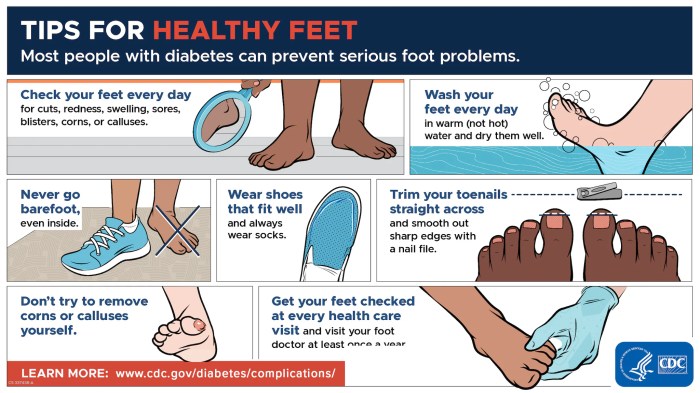
Welcome to the ultimate guide on foot care for diabetics! Get ready to dive into a world where pampering your feet is not just a luxury, but a necessity for those with diabetes. Let’s explore the importance, preventive measures, common problems, cosmetic solutions, heart disease connection, and even the link between diabetes and eating disorders. Get comfy, this journey is about to begin!
Importance of Foot Care for Diabetics

Proper foot care is essential for individuals with diabetes to prevent serious complications and maintain overall health.
Risks of Poor Foot Care in Diabetics
- Decreased blood flow to the feet leading to slow healing of wounds
- Nerve damage causing loss of sensation and increased risk of injuries
- Development of foot ulcers that can lead to infections and even amputations
Statistics on Foot Complications in Diabetics
According to the American Diabetes Association, about 15% of people with diabetes will develop a foot ulcer at some point in their lives.
Diabetic foot ulcers have a recurrence rate of up to 40% within one year of healing.
Preventive Foot Care Measures
Regular foot care is essential for diabetics to prevent serious complications. By following daily foot care practices, undergoing regular foot exams, and wearing proper footwear, individuals can reduce the risk of developing foot problems associated with diabetes.
Daily Foot Care Practices for Diabetics
- Inspect your feet daily for any cuts, sores, blisters, or redness.
- Wash your feet with lukewarm water and mild soap, ensuring to dry them thoroughly, especially between the toes.
- Apply moisturizer to prevent dry skin but avoid applying between the toes to prevent fungal infections.
- Trim your toenails straight across and avoid cutting into the corners to prevent ingrown toenails.
- Avoid walking barefoot and always wear clean, dry socks and properly fitting shoes.
Importance of Regular Foot Exams
Regular foot exams performed by a healthcare professional can help detect any early signs of foot issues. These exams can identify problems such as nerve damage, poor circulation, or foot deformities, allowing for timely intervention to prevent further complications.
Role of Proper Footwear
Wearing proper footwear plays a crucial role in preventing foot problems for diabetics. Shoes should provide adequate support, cushioning, and protection to reduce the risk of developing ulcers or injuries. It is essential to choose shoes that fit well, have a wide toe box, and do not cause friction or pressure points on the feet.
Common Foot Problems in Diabetics
Diabetes can lead to various foot problems due to nerve damage and poor blood circulation. These issues can range from minor irritations to serious infections if not properly managed.
Diabetic Foot Ulcers
Diabetic foot ulcers are one of the most common complications that diabetics face. These are open sores or wounds that typically develop on the bottom of the foot. The main causes of diabetic foot ulcers include neuropathy, poor circulation, and foot deformities. Symptoms of diabetic foot ulcers may include redness, swelling, drainage, or odor from the wound.
It is crucial to seek immediate medical attention if you notice any signs of a foot ulcer to prevent further complications.
Neuropathy and its Impact
Neuropathy is a condition that affects the nerves in the body, particularly in the feet for diabetics. It can cause numbness, tingling, or burning sensations in the feet, making it difficult to feel injuries or ulcers developing. Neuropathy increases the risk of foot complications as diabetics may not notice when there is a problem with their feet.
Regular foot exams and proper foot care are essential in managing neuropathy and preventing serious foot issues.
Cosmetic Surgery in Diabetic Foot Care
Cosmetic surgery plays a crucial role in treating foot complications in diabetics by addressing issues such as ulcers, deformities, and other aesthetic concerns that can arise due to the condition. Not only does it help improve the overall appearance of the feet, but it also enhances foot health and functionality.
Benefits of Cosmetic Procedures for Diabetic Foot Care
- Cosmetic surgery can help correct deformities caused by diabetic neuropathy, such as hammertoes or bunions, improving the alignment of the feet and reducing the risk of ulcers.
- Procedures like skin grafts or tissue reconstruction can aid in healing chronic wounds or ulcers that are common in diabetic patients, preventing further complications.
- By addressing calluses, corns, or ingrown toenails through cosmetic interventions, diabetic individuals can experience relief from pain and discomfort, promoting better mobility.
Considerations and Risks of Cosmetic Surgery for Diabetic Patients
- Before undergoing any cosmetic procedure, diabetic patients must consult with their healthcare provider to assess the risks involved and ensure their overall health condition can tolerate the surgery.
- Complications such as delayed wound healing, infection, or nerve damage may be more prevalent in diabetic individuals, making it crucial to follow post-operative care instructions diligently.
- Proper wound care, monitoring blood sugar levels, and managing any underlying conditions are essential to minimize the risks associated with cosmetic surgery for diabetic foot care.
Foot Health and Heart Disease

Foot health and heart disease are closely linked in diabetics. The impact of foot problems on cardiovascular health cannot be underestimated. It is crucial for individuals with diabetes to take proactive measures to maintain both foot health and heart health simultaneously.
Connection Between Foot Health and Heart Disease
Maintaining good foot health is essential for diabetics as foot problems can lead to poor circulation and nerve damage, increasing the risk of heart disease. The connection lies in the fact that diabetes affects blood flow and nerve function, making individuals more susceptible to both foot complications and heart issues.
- Proper foot care, including daily inspection, moisturizing, and wearing comfortable shoes, can help prevent foot problems that may impact cardiovascular health.
- Regular exercise, a healthy diet, and keeping blood sugar levels in check are crucial for managing diabetes and reducing the risk of heart disease.
- Consulting with healthcare professionals for regular foot exams and heart screenings can help detect any issues early and prevent complications.
Diabetes and Eating Disorders
Eating disorders can have a significant impact on individuals with diabetes, as they can disrupt blood sugar levels and overall health. Proper management of both conditions is crucial for promoting well-being.
Effects of Eating Disorders on Foot Health
- Eating disorders such as bulimia can lead to electrolyte imbalances, which can affect nerve function in the feet.
- Severe calorie restriction can result in poor circulation, increasing the risk of foot ulcers and infections.
- Unstable blood sugar levels due to irregular eating patterns can contribute to nerve damage and delayed wound healing in the feet.
Tips for Managing Diabetes and Eating Disorders
- Seek professional help from healthcare providers experienced in treating both diabetes and eating disorders.
- Follow a balanced meal plan that meets the nutritional needs of diabetes while addressing the challenges of an eating disorder.
- Monitor blood sugar levels regularly and adjust insulin doses as needed to maintain stability.
- Practice self-care techniques such as mindfulness, stress management, and seeking support from loved ones or support groups.
Last Recap
As we wrap up our foot care adventure, remember that taking care of your feet is more than just a routine – it’s a way to ensure your overall well-being. So, step into each day with knowledge, awareness, and a little extra love for those hard-working feet of yours. Here’s to happy and healthy feet for life!
Quick FAQs
How often should diabetics check their feet?
It is recommended for diabetics to check their feet daily for any cuts, sores, or blisters.
Can wearing proper footwear really make a difference for diabetics?
Absolutely! Proper footwear can help prevent foot issues and provide necessary support for diabetic individuals.
Are diabetic foot ulcers treatable with non-surgical methods?
Depending on the severity, some diabetic foot ulcers can be treated with non-surgical methods like medications and wound care.
How can diabetes impact heart health through foot problems?
Foot problems in diabetics can lead to reduced mobility, affecting cardiovascular health due to lack of physical activity.
What are some tips for managing diabetes and eating disorders simultaneously?
It’s important to seek professional help, create a balanced meal plan, and prioritize both physical and mental health.





